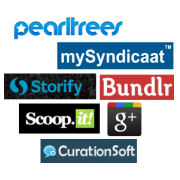I think I'll use a combination of Delicious, Pearltrees and Instapaper.
I'll use Instapaper as a repository to store those papers and documents I want to read later. Although I'm not sure if I'm going to use it in the future, since the features it offers can be already obtained by means of bookmarks in Google Chrome, once you set up automatic synchronization of Chrome between machines. The only missing feature would be sharing to social media, but that's also easily obtainable.
Delicious and Pearltrees are two tools that I already use. Delicious can be used to easily discover new content. Pearltrees offers an interesting interface to store and discover new sources and, lastly, they seem to have improved it (at least it seems more usable in terms of speed).
I've reviewd the list of curation tools offered by the linked article. From the 60 tools (30 in the linked article and 30 more from a second part that can be fetched from the former article), only 5 convinced me to pay a closer attention: Bundlr, BagToWeb, Scoop.it, Diigo and StoryCrawler. From these, StoryCrawler I was unable to open a new account a use it. So I can't really assess its usefulness.
BagToWeb, from my point of view, does not offer features beyond what Delicious or any curation tool that provides tags to create a folksonomy. The most interesting feature is linking bags, but that can be also obtained with tags, although the metaphor of bags is more user-friendly to understand how to classify things.
Bundlr is pretty interesting. Similar to delicious, it has a nice front-end and a visually appealing way to present content. It also offers you the possibility to know how many people have visited your bundle.
Finally, Scoop.it, which I think it has interesting features, although I couldn't see how these could help me.

















